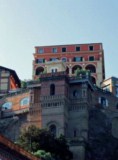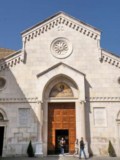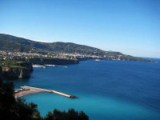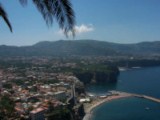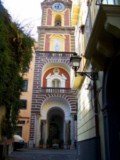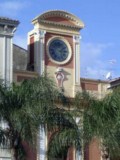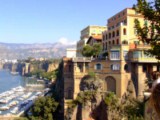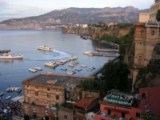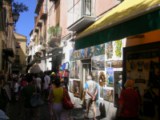|
SORRENTO - AMALFI COAST - CAMPANIA - SOUTH ITALY TRADITIONS & LOCAL PRODUCTS VISIT AND SEE HISTORY AND BACKGROUND Sorrento and the Amalfi Coast are some of the most important visiting tourist resort of the South Italy, attracting many visitors every year from worldwide nations like United States, Japan & Europe.
Sorrento, Mediterranean land that has been depicted, described and immortalised in song by artists, poets and travellers from every period of history. Its rugged coast, with inaccessible cliffs that soar upwards between beautiful beaches, hidden caves, enchanting bays and sheltered coves. Its inland, with the high plains, rolling hills and lofty mountains are seared by deep valleys to create a truly unique landscape in which man has also left a clear sign of his remarkable work: the more impervious areas have been modelled into the now-famous terraces, those huge steps descending into the sea on which man has planted vine yards and orange and lemon groves as well as olive trees. These are the gardens of delight that release a sweet and enchanting perfume of blossom in spring time. Of Phoenician origin and known all around the world as a climatic and holiday resort Sorrento is a very old town also known as "Cittą delle Sirene" (town of the mermaids) as well as "Cittą degli aranci" (town of the orange trees) that is part of the Amalfi Coast, just opposite Capri and close to other world wide known holiday resorts like Ischia, Procida, Positano and Ravello. This edge of paradise was the native town of Torquato Tasso (1544), a great man of literature, one of the greatest poets of the sixteenth century and also singer of "Gerusalemme Liberata". Thanks to the Grand Tours in the Romantic Age, pictures, travel reports, films on the notes of the wonderful and immortal "Torna a Surriento", song written by De Curtis, Sorrento has always been an attraction for each traveller. The mild climate and predominantly fine weather all year round make the "Penisola di Sorrento" an ideal destination in any season. In a well-ordered and secure environment, every tourist can have an ideal holiday and be spoilt for choice with the never ending combinations of countryside and tranquillity, health and culture, sea beauties, spa baths, boat day trip and country walks. Sorrento, has been for centuries characterized by its lands, cultivation, kinds of settlements and social-cultural attitude of its inhabitants. Even today the nature of the ground, an alternating of tufa and limestone rocks, has created a type of soil particularly suitable for tree cultivations. The agriculture of this green land, with a multitude of vineyards and olive groves, displays a prevalence of citrus fruit (orange and above all lemon groves) which gives the landscape that particular colour typical of the oranges and lemons and creating a fascinating counterpoint with the silvery green of the olives. This still quite original setting impresses and attracts visitors, from all around the world. These lands have also given life to some traditions handed down through generations. One of the most important is, undoubtedly, an old recipe from which you obtain the typical liqueur "Limoncello" an exquisite fresh local produce to be consumed mainly in the summer and served ice cold. The Limoncello, who's production is very popular throughout the Amalfi Coast is an absolute natural product, the result of an infusion of lemon skin in pure alcohol, using the juiciest lemons cultivated and harvested in this area. Although Limoncello is the most famous one, the peninsular produces a number of fine liqueurs distilled from local produce, such as mandarins, oranges and walnuts. Another recipe handed down through the years is the "Nocino", rosolio prepared with the exquisite walnuts of Sorrento to taste after a good meal. Produced between the Saint's day of St. John and St. Paul, precisely in the period from 2nd to 24th June, the moon becomes favourable for this delicate operation, as the walnuts are still enclosed in their husks. Sorrento has always been rich in spring-waters, an endowment which has allowed the vegetation to burst out in full bloom and give a pleasant coolness in some areas. Healthy water, good climate, excellent fodder and healthy cows have renowned the whole area for its juiciest dairy products. The most important is the "Treccia" (pleated cottage cheese) a fresh milk cheese combined with a swilled paste left to a natural fermentation and prolonged overnight to enhance the aroma and the taste of the milk itself. The thousands of local cultural traditions show that there is always a special event any time of year:
Handicrafts are also plentiful: first and foremost the inlaid wood and marquetry craft, although there is also a flourishing trade in a small boats and pleasure craft. Rich of monuments and natural beauties, worth while a visit, don't miss:
According to this legend, the origin of the town dates back to an ancient Italic population, the Ausoni, which accounted for one of the most ancient ethnic groups. However the town in pre-Roman age became subject to a certain influence by the Greek culture, whose traces can be easily found in its urbanistic settlement, like the remains of the "Parsano Gate", "Marina Grande Gate", let alone the presence at the headland of the peninsula called "Punta Campanella", of the Athenaion. The big sanctuary, used to worship Athens, was, according to the legend, founded by Ulysses and in a first moment consecrated to the worship of the goddess Sirens whose sweet song was a lure that no mariner could defy. The Greek influence seems to be present in the period between 474 and 420 b.C., when Sorrento was conquered by the Samniti. After the Ancient Greeks, Sorrento fascinated the Romans who were enraptured by its boundless beauty and natural resources bringing its fame throughout the world. However Sorrento rebelled against the Roman domination during the social war, when, after joining the "nucerina alliance" it was reconquered, together with Stabia, by Papius Multius in 90 b.C. The Romans built a road as far as the headland known as "Punta Campanella" and constructed on the coast, small harbours, fish-tanks, nymphaea and baths using local spring water to embellish their sumptuous villas, such as the one of "Pollius Felix" also commemorated by Horace in his work Silvae where he praised the beautiful sights of this Villa. Later, during the Middle Ages and more recently in time, the local population engaged in bustling trade in spite of the ever present threat of the Saracen pirates, contending supremacy in the North Tyrrhenian sea with Amalfi and Naples, and continued to live fearlessly along the coast in the exquisite harbours: Marina di Aequa, Marina Grande and Marina della Lobra. The Spaniards who governed great part of southern Italy for a sizeable part of the modern age, appreciated the area for its abundance of fruits, fish, birds, meat and cheeses. While in the eighteenth century, the Penisola di Sorrento, was discovered by the grand tour and intellectuals from all over Europe, including Nietzsche and Ibsen, who found spiritual and cultural nourishment here, unveiling the taste for living in a villa, which made the Sorrentine Peninsular a popular resort. On 24th August 79 a.D. the town was seriously damaged by the earthquake, caused by the eruption of the Vesuvius which destroyed the towns surrounding the area such as Pompei, Herculaneum and Stabia. You may consider staying in the area between Maratea and Diamante central to the whole of the South Italy, so please check the availability below and book a Hotel accommodation by the sea or in the beutiful rural area and center point for other major South Italy destinations within a few hours of relaxing, discovering car drive. Distances to the Amalfi Coast approx. Check Hotel Accommodation availability and book in these towns:
|
||||||||||||||||||||


